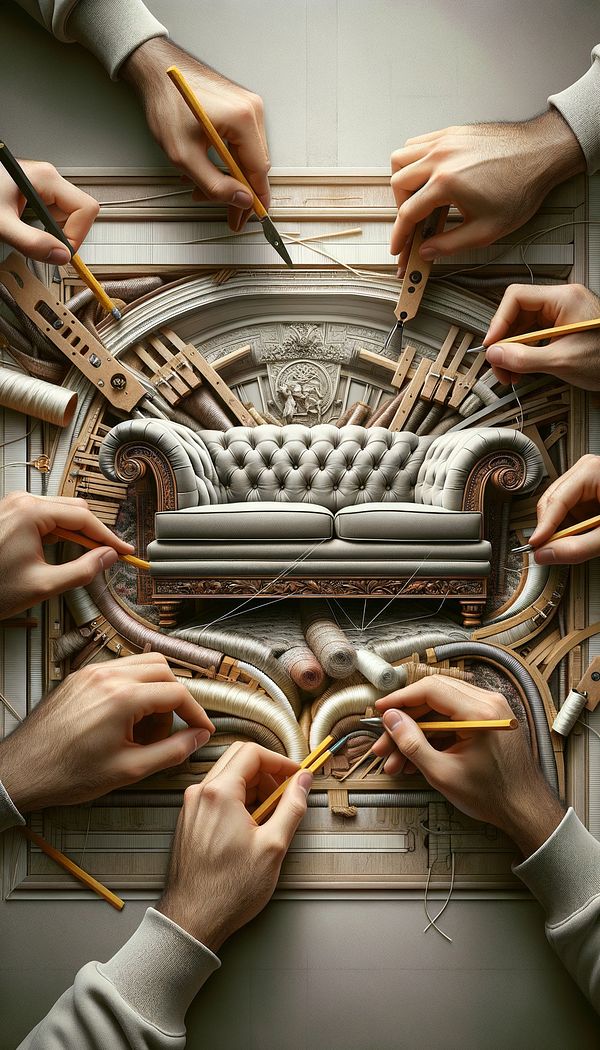What is Eight-Way Hand Tied?
Eight-Way Hand Tied is a traditional method of sofa and chair construction known for its durability and comfort.
Description
Eight-Way Hand Tied is revered as the gold standard in the upholstery furniture industry, cherished for the unparalleled support and comfort it lends to sofas and chairs. The method involves intricately tying springs to the furniture's frame by hand, using strong twine that runs from each spring in eight different directions. This meticulous technique ensures that each spring moves independently, providing a balanced, supportive seat that adapts to the weight and shape of the person sitting on it.
The process of creating an Eight-Way Hand Tied piece of furniture is labor-intensive and requires a high level of skill and craftsmanship, making it a hallmark of quality in upholstered furniture. The springs are tied to the frame at the top, center, and bottom. This not only prevents the springs from shifting and sagging over time but also distributes the sitter's weight evenly across the seat, contributing to the furniture's longevity and the sitter's comfort. As such, Eight-Way Hand Tied furniture is a significant investment, reflecting both the time-honored techniques used in its creation and the quality of the craftsmanship.
Furniture featuring the Eight-Way Hand Tied method is often associated with luxury, traditional design, and superior comfort. However, advances in technology and furniture design have introduced alternative methods that also promise durability and comfort, such as sinuous spring systems or webbing. Nevertheless, for many, the traditional Eight-Way Hand Tied method remains the benchmark for quality in upholstered seating.
Usage
Eight-Way Hand Tied springs are primarily found in high-end sofas and armchairs, popular among enthusiasts of traditional furniture making and those willing to invest in pieces that prioritize comfort, support, and durability.
FAQs
-
How does Eight-Way Hand Tied construction enhance furniture durability?
Eight-Way Hand Tied construction enhances furniture durability by securing the springs to the frame in eight different directions, preventing them from shifting or sagging over time. This even distribution of weight ensures the furniture retains its shape and support for a longer period.
-
Is furniture with Eight-Way Hand Tied springs more expensive?
Yes, furniture featuring Eight-Way Hand Tied springs tend to be more expensive due to the labor-intensive process and high level of craftsmanship required. It is considered a mark of quality and luxury in upholstery furniture.
-
Can I find Eight-Way Hand Tied construction in modern furniture?
While Eight-Way Hand Tied construction is often associated with traditional furniture, it can also be found in some modern designs that prioritize quality and comfort. However, there are alternative construction methods available in contemporary furniture that also offer durability and comfort.
Practical Application
When shopping for premium upholstered furniture, look for pieces featuring Eight-Way Hand Tied construction if you prioritize top-notch support, comfort, and durability. Though it might come at a higher cost, the investment is often justified by the unparalleled quality and longevity of the furniture. Always inquire about the construction methods used in a sofa or chair to ensure you are getting the level of craftsmanship you desire.
-
Furniture Types599 articles
-
Historical Periods & Movements150 articles
-
Technical Terms38 articles
-
Fabrication & Craftsmanship133 articles
-
Materials & Textiles360 articles
-
SplashbackA surface material installed behind a sink or stove to protect walls from splashes and stains.
-
DownDown refers to the soft layers of fine feathers found beneath the tougher exterior feathers of birds, often used for insulation and padding in a variety of interior design elements.
-
BowbackA design feature in chairs where the back consists of a curved piece of wood.
-
Platform BedA low-profile bed frame with a solid or slated base designed to support a mattress without the need for a box spring.
-
Dry BrushingDry brushing is a painting technique used to create a textured effect.
